Addressing Health Inequalities Report
VerifiedAdded on 2020/10/23
|11
|2365
|145
Report
AI Summary
This report addresses health inequalities among Indigenous Australians, focusing on the role of Aboriginal Community Controlled Health Services (ACCHS), the importance of self-determination, and the contributions of health workers. It discusses strategies for improving health outcomes and the impact of cultural competency in healthcare delivery.
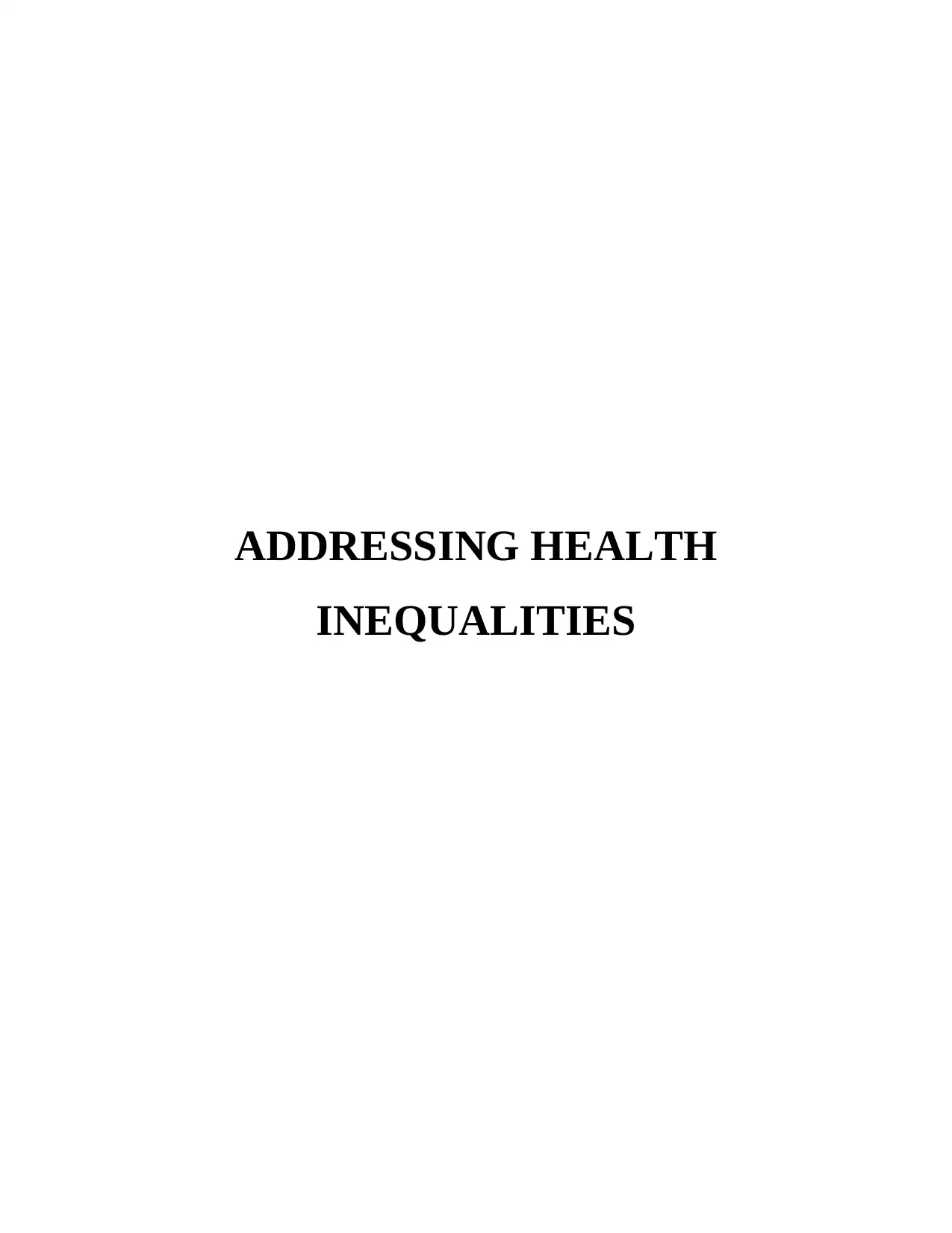
ADDRESSING HEALTH
INEQUALITIES
INEQUALITIES
Paraphrase This Document
Need a fresh take? Get an instant paraphrase of this document with our AI Paraphraser
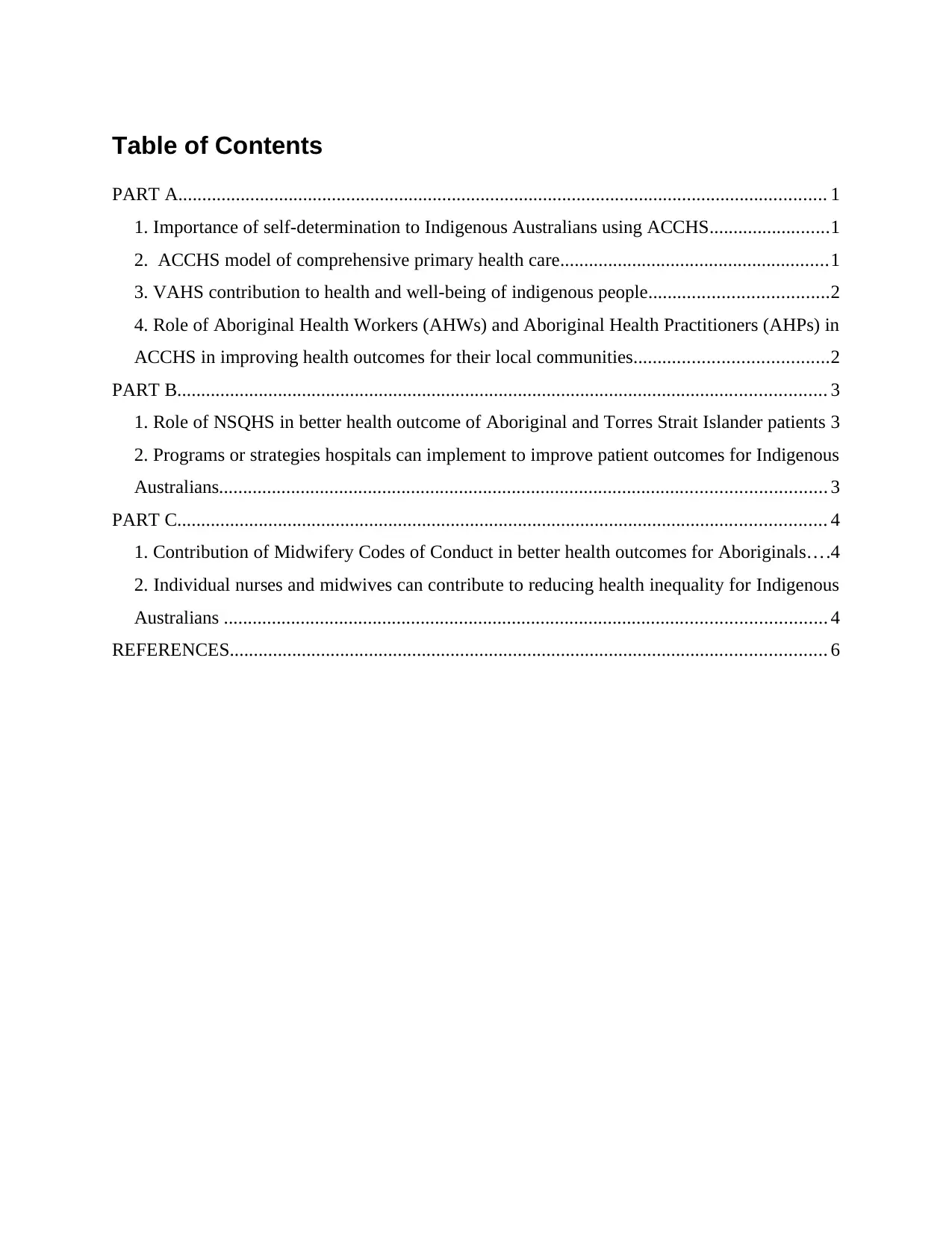
Table of Contents
PART A....................................................................................................................................... 1
1. Importance of self-determination to Indigenous Australians using ACCHS.........................1
2. ACCHS model of comprehensive primary health care........................................................1
3. VAHS contribution to health and well-being of indigenous people.....................................2
4. Role of Aboriginal Health Workers (AHWs) and Aboriginal Health Practitioners (AHPs) in
ACCHS in improving health outcomes for their local communities........................................2
PART B....................................................................................................................................... 3
1. Role of NSQHS in better health outcome of Aboriginal and Torres Strait Islander patients 3
2. Programs or strategies hospitals can implement to improve patient outcomes for Indigenous
Australians.............................................................................................................................. 3
PART C....................................................................................................................................... 4
1. Contribution of Midwifery Codes of Conduct in better health outcomes for Aboriginals....4
2. Individual nurses and midwives can contribute to reducing health inequality for Indigenous
Australians ............................................................................................................................. 4
REFERENCES............................................................................................................................ 6
PART A....................................................................................................................................... 1
1. Importance of self-determination to Indigenous Australians using ACCHS.........................1
2. ACCHS model of comprehensive primary health care........................................................1
3. VAHS contribution to health and well-being of indigenous people.....................................2
4. Role of Aboriginal Health Workers (AHWs) and Aboriginal Health Practitioners (AHPs) in
ACCHS in improving health outcomes for their local communities........................................2
PART B....................................................................................................................................... 3
1. Role of NSQHS in better health outcome of Aboriginal and Torres Strait Islander patients 3
2. Programs or strategies hospitals can implement to improve patient outcomes for Indigenous
Australians.............................................................................................................................. 3
PART C....................................................................................................................................... 4
1. Contribution of Midwifery Codes of Conduct in better health outcomes for Aboriginals....4
2. Individual nurses and midwives can contribute to reducing health inequality for Indigenous
Australians ............................................................................................................................. 4
REFERENCES............................................................................................................................ 6
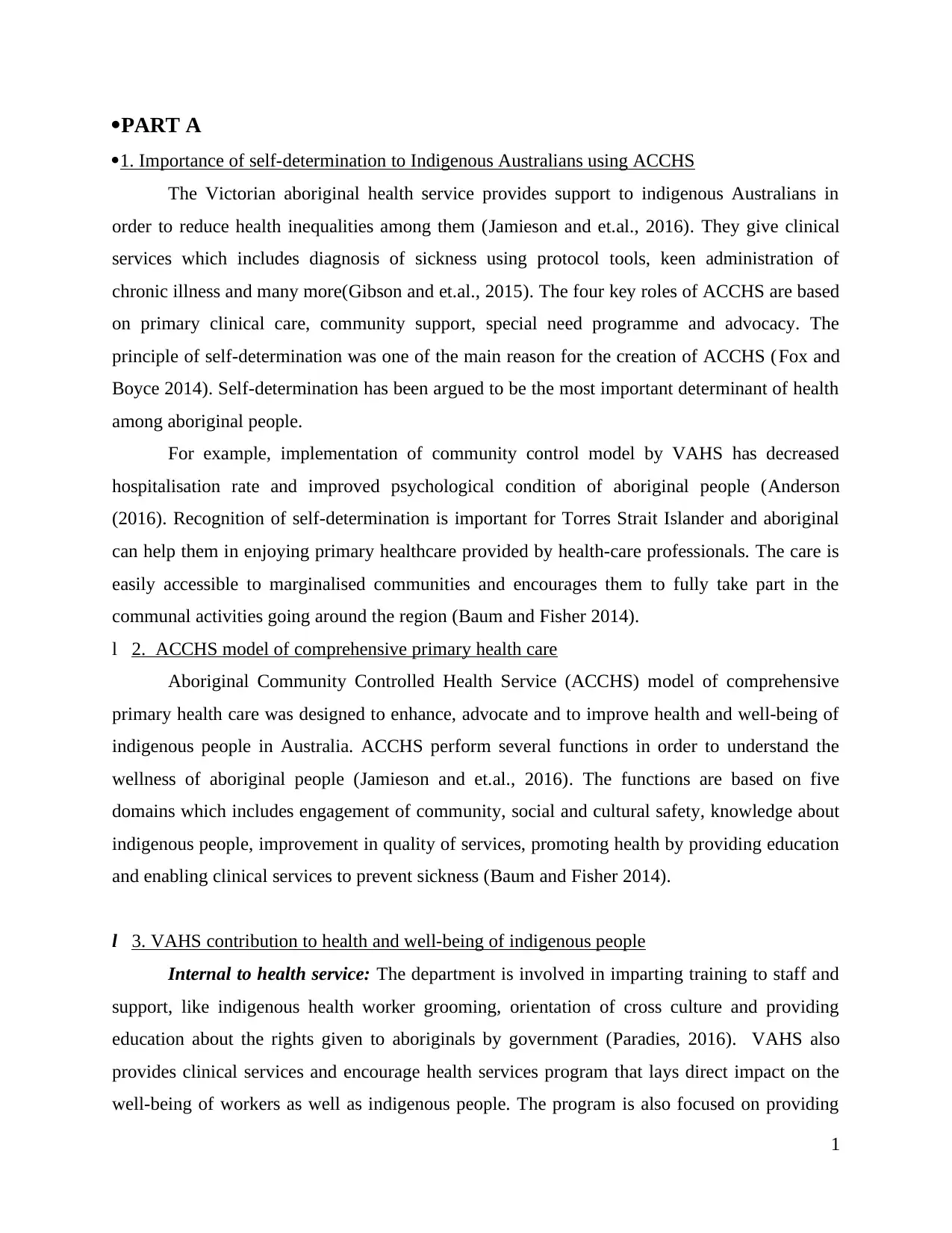
·PART A
·1. Importance of self-determination to Indigenous Australians using ACCHS
The Victorian aboriginal health service provides support to indigenous Australians in
order to reduce health inequalities among them (Jamieson and et.al., 2016). They give clinical
services which includes diagnosis of sickness using protocol tools, keen administration of
chronic illness and many more(Gibson and et.al., 2015). The four key roles of ACCHS are based
on primary clinical care, community support, special need programme and advocacy. The
principle of self-determination was one of the main reason for the creation of ACCHS (Fox and
Boyce 2014). Self-determination has been argued to be the most important determinant of health
among aboriginal people.
For example, implementation of community control model by VAHS has decreased
hospitalisation rate and improved psychological condition of aboriginal people (Anderson
(2016). Recognition of self-determination is important for Torres Strait Islander and aboriginal
can help them in enjoying primary healthcare provided by health-care professionals. The care is
easily accessible to marginalised communities and encourages them to fully take part in the
communal activities going around the region (Baum and Fisher 2014).
l壱2. ACCHS model of comprehensive primary health care
Aboriginal Community Controlled Health Service (ACCHS) model of comprehensive
primary health care was designed to enhance, advocate and to improve health and well-being of
indigenous people in Australia. ACCHS perform several functions in order to understand the
wellness of aboriginal people (Jamieson and et.al., 2016). The functions are based on five
domains which includes engagement of community, social and cultural safety, knowledge about
indigenous people, improvement in quality of services, promoting health by providing education
and enabling clinical services to prevent sickness (Baum and Fisher 2014).
l壱3. VAHS contribution to health and well-being of indigenous people
Internal to health service: The department is involved in imparting training to staff and
support, like indigenous health worker grooming, orientation of cross culture and providing
education about the rights given to aboriginals by government (Paradies, 2016). VAHS also
provides clinical services and encourage health services program that lays direct impact on the
well-being of workers as well as indigenous people. The program is also focused on providing
1
·1. Importance of self-determination to Indigenous Australians using ACCHS
The Victorian aboriginal health service provides support to indigenous Australians in
order to reduce health inequalities among them (Jamieson and et.al., 2016). They give clinical
services which includes diagnosis of sickness using protocol tools, keen administration of
chronic illness and many more(Gibson and et.al., 2015). The four key roles of ACCHS are based
on primary clinical care, community support, special need programme and advocacy. The
principle of self-determination was one of the main reason for the creation of ACCHS (Fox and
Boyce 2014). Self-determination has been argued to be the most important determinant of health
among aboriginal people.
For example, implementation of community control model by VAHS has decreased
hospitalisation rate and improved psychological condition of aboriginal people (Anderson
(2016). Recognition of self-determination is important for Torres Strait Islander and aboriginal
can help them in enjoying primary healthcare provided by health-care professionals. The care is
easily accessible to marginalised communities and encourages them to fully take part in the
communal activities going around the region (Baum and Fisher 2014).
l壱2. ACCHS model of comprehensive primary health care
Aboriginal Community Controlled Health Service (ACCHS) model of comprehensive
primary health care was designed to enhance, advocate and to improve health and well-being of
indigenous people in Australia. ACCHS perform several functions in order to understand the
wellness of aboriginal people (Jamieson and et.al., 2016). The functions are based on five
domains which includes engagement of community, social and cultural safety, knowledge about
indigenous people, improvement in quality of services, promoting health by providing education
and enabling clinical services to prevent sickness (Baum and Fisher 2014).
l壱3. VAHS contribution to health and well-being of indigenous people
Internal to health service: The department is involved in imparting training to staff and
support, like indigenous health worker grooming, orientation of cross culture and providing
education about the rights given to aboriginals by government (Paradies, 2016). VAHS also
provides clinical services and encourage health services program that lays direct impact on the
well-being of workers as well as indigenous people. The program is also focused on providing
1
⊘ This is a preview!⊘
Do you want full access?
Subscribe today to unlock all pages.

Trusted by 1+ million students worldwide
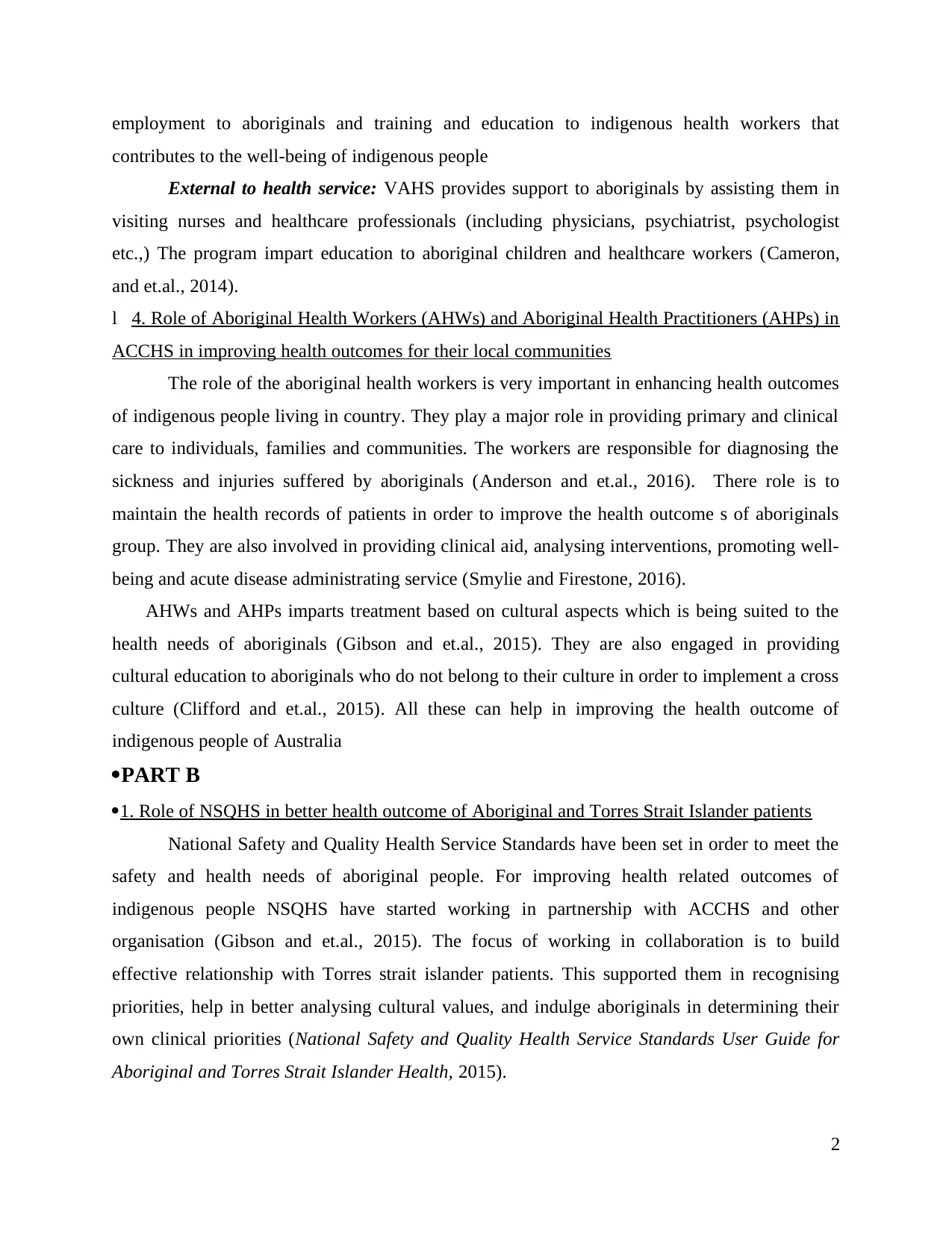
employment to aboriginals and training and education to indigenous health workers that
contributes to the well-being of indigenous people
External to health service: VAHS provides support to aboriginals by assisting them in
visiting nurses and healthcare professionals (including physicians, psychiatrist, psychologist
etc.,) The program impart education to aboriginal children and healthcare workers (Cameron,
and et.al., 2014).
l壱4. Role of Aboriginal Health Workers (AHWs) and Aboriginal Health Practitioners (AHPs) in
ACCHS in improving health outcomes for their local communities
The role of the aboriginal health workers is very important in enhancing health outcomes
of indigenous people living in country. They play a major role in providing primary and clinical
care to individuals, families and communities. The workers are responsible for diagnosing the
sickness and injuries suffered by aboriginals (Anderson and et.al., 2016). There role is to
maintain the health records of patients in order to improve the health outcome s of aboriginals
group. They are also involved in providing clinical aid, analysing interventions, promoting well-
being and acute disease administrating service (Smylie and Firestone, 2016).
AHWs and AHPs imparts treatment based on cultural aspects which is being suited to the
health needs of aboriginals (Gibson and et.al., 2015). They are also engaged in providing
cultural education to aboriginals who do not belong to their culture in order to implement a cross
culture (Clifford and et.al., 2015). All these can help in improving the health outcome of
indigenous people of Australia
·PART B
·1. Role of NSQHS in better health outcome of Aboriginal and Torres Strait Islander patients
National Safety and Quality Health Service Standards have been set in order to meet the
safety and health needs of aboriginal people. For improving health related outcomes of
indigenous people NSQHS have started working in partnership with ACCHS and other
organisation (Gibson and et.al., 2015). The focus of working in collaboration is to build
effective relationship with Torres strait islander patients. This supported them in recognising
priorities, help in better analysing cultural values, and indulge aboriginals in determining their
own clinical priorities (National Safety and Quality Health Service Standards User Guide for
Aboriginal and Torres Strait Islander Health, 2015).
2
contributes to the well-being of indigenous people
External to health service: VAHS provides support to aboriginals by assisting them in
visiting nurses and healthcare professionals (including physicians, psychiatrist, psychologist
etc.,) The program impart education to aboriginal children and healthcare workers (Cameron,
and et.al., 2014).
l壱4. Role of Aboriginal Health Workers (AHWs) and Aboriginal Health Practitioners (AHPs) in
ACCHS in improving health outcomes for their local communities
The role of the aboriginal health workers is very important in enhancing health outcomes
of indigenous people living in country. They play a major role in providing primary and clinical
care to individuals, families and communities. The workers are responsible for diagnosing the
sickness and injuries suffered by aboriginals (Anderson and et.al., 2016). There role is to
maintain the health records of patients in order to improve the health outcome s of aboriginals
group. They are also involved in providing clinical aid, analysing interventions, promoting well-
being and acute disease administrating service (Smylie and Firestone, 2016).
AHWs and AHPs imparts treatment based on cultural aspects which is being suited to the
health needs of aboriginals (Gibson and et.al., 2015). They are also engaged in providing
cultural education to aboriginals who do not belong to their culture in order to implement a cross
culture (Clifford and et.al., 2015). All these can help in improving the health outcome of
indigenous people of Australia
·PART B
·1. Role of NSQHS in better health outcome of Aboriginal and Torres Strait Islander patients
National Safety and Quality Health Service Standards have been set in order to meet the
safety and health needs of aboriginal people. For improving health related outcomes of
indigenous people NSQHS have started working in partnership with ACCHS and other
organisation (Gibson and et.al., 2015). The focus of working in collaboration is to build
effective relationship with Torres strait islander patients. This supported them in recognising
priorities, help in better analysing cultural values, and indulge aboriginals in determining their
own clinical priorities (National Safety and Quality Health Service Standards User Guide for
Aboriginal and Torres Strait Islander Health, 2015).
2
Paraphrase This Document
Need a fresh take? Get an instant paraphrase of this document with our AI Paraphraser
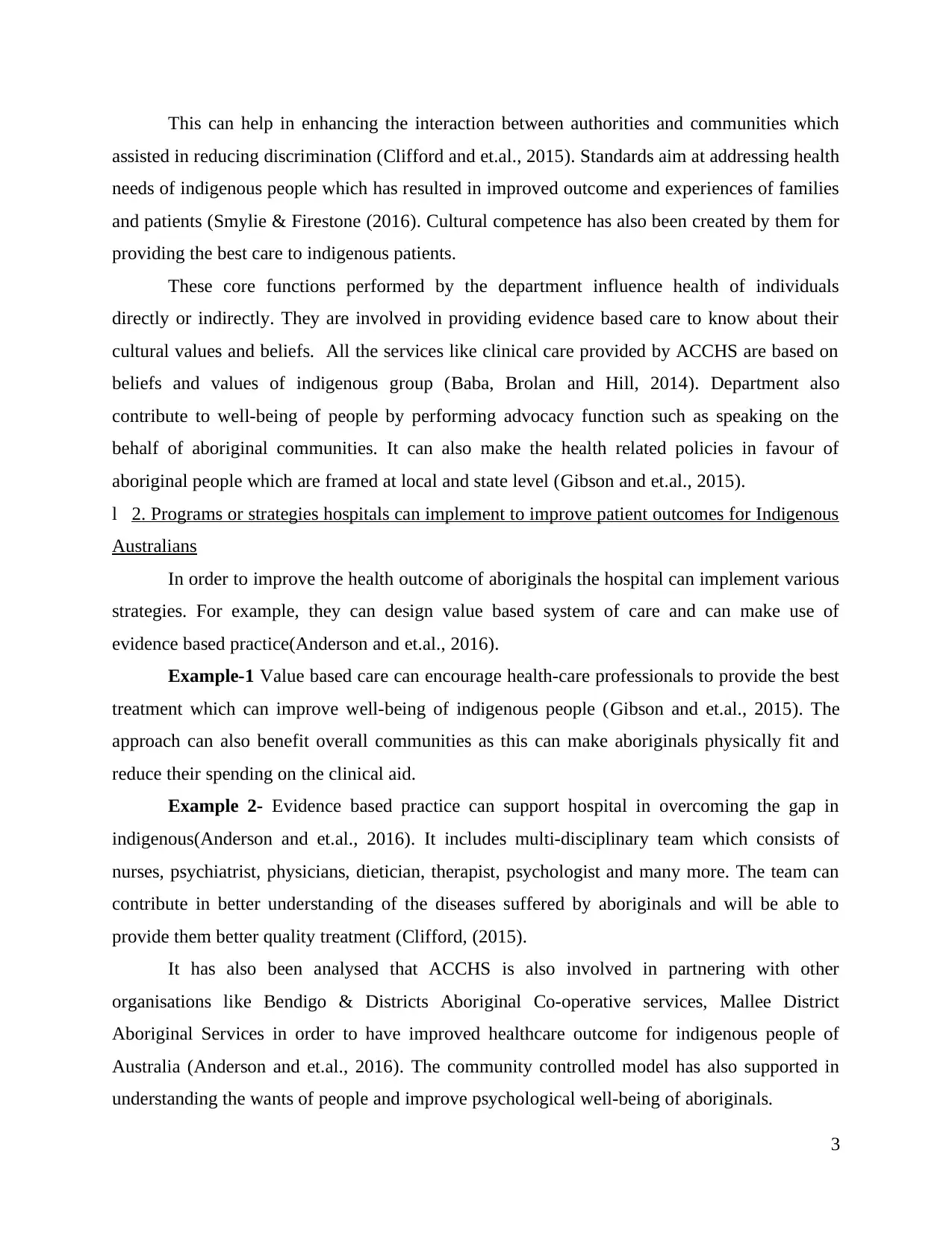
This can help in enhancing the interaction between authorities and communities which
assisted in reducing discrimination (Clifford and et.al., 2015). Standards aim at addressing health
needs of indigenous people which has resulted in improved outcome and experiences of families
and patients (Smylie & Firestone (2016). Cultural competence has also been created by them for
providing the best care to indigenous patients.
These core functions performed by the department influence health of individuals
directly or indirectly. They are involved in providing evidence based care to know about their
cultural values and beliefs. All the services like clinical care provided by ACCHS are based on
beliefs and values of indigenous group (Baba, Brolan and Hill, 2014). Department also
contribute to well-being of people by performing advocacy function such as speaking on the
behalf of aboriginal communities. It can also make the health related policies in favour of
aboriginal people which are framed at local and state level (Gibson and et.al., 2015).
l壱2. Programs or strategies hospitals can implement to improve patient outcomes for Indigenous
Australians
In order to improve the health outcome of aboriginals the hospital can implement various
strategies. For example, they can design value based system of care and can make use of
evidence based practice(Anderson and et.al., 2016).
Example-1 Value based care can encourage health-care professionals to provide the best
treatment which can improve well-being of indigenous people (Gibson and et.al., 2015). The
approach can also benefit overall communities as this can make aboriginals physically fit and
reduce their spending on the clinical aid.
Example 2- Evidence based practice can support hospital in overcoming the gap in
indigenous(Anderson and et.al., 2016). It includes multi-disciplinary team which consists of
nurses, psychiatrist, physicians, dietician, therapist, psychologist and many more. The team can
contribute in better understanding of the diseases suffered by aboriginals and will be able to
provide them better quality treatment (Clifford, (2015).
It has also been analysed that ACCHS is also involved in partnering with other
organisations like Bendigo & Districts Aboriginal Co-operative services, Mallee District
Aboriginal Services in order to have improved healthcare outcome for indigenous people of
Australia (Anderson and et.al., 2016). The community controlled model has also supported in
understanding the wants of people and improve psychological well-being of aboriginals.
3
assisted in reducing discrimination (Clifford and et.al., 2015). Standards aim at addressing health
needs of indigenous people which has resulted in improved outcome and experiences of families
and patients (Smylie & Firestone (2016). Cultural competence has also been created by them for
providing the best care to indigenous patients.
These core functions performed by the department influence health of individuals
directly or indirectly. They are involved in providing evidence based care to know about their
cultural values and beliefs. All the services like clinical care provided by ACCHS are based on
beliefs and values of indigenous group (Baba, Brolan and Hill, 2014). Department also
contribute to well-being of people by performing advocacy function such as speaking on the
behalf of aboriginal communities. It can also make the health related policies in favour of
aboriginal people which are framed at local and state level (Gibson and et.al., 2015).
l壱2. Programs or strategies hospitals can implement to improve patient outcomes for Indigenous
Australians
In order to improve the health outcome of aboriginals the hospital can implement various
strategies. For example, they can design value based system of care and can make use of
evidence based practice(Anderson and et.al., 2016).
Example-1 Value based care can encourage health-care professionals to provide the best
treatment which can improve well-being of indigenous people (Gibson and et.al., 2015). The
approach can also benefit overall communities as this can make aboriginals physically fit and
reduce their spending on the clinical aid.
Example 2- Evidence based practice can support hospital in overcoming the gap in
indigenous(Anderson and et.al., 2016). It includes multi-disciplinary team which consists of
nurses, psychiatrist, physicians, dietician, therapist, psychologist and many more. The team can
contribute in better understanding of the diseases suffered by aboriginals and will be able to
provide them better quality treatment (Clifford, (2015).
It has also been analysed that ACCHS is also involved in partnering with other
organisations like Bendigo & Districts Aboriginal Co-operative services, Mallee District
Aboriginal Services in order to have improved healthcare outcome for indigenous people of
Australia (Anderson and et.al., 2016). The community controlled model has also supported in
understanding the wants of people and improve psychological well-being of aboriginals.
3
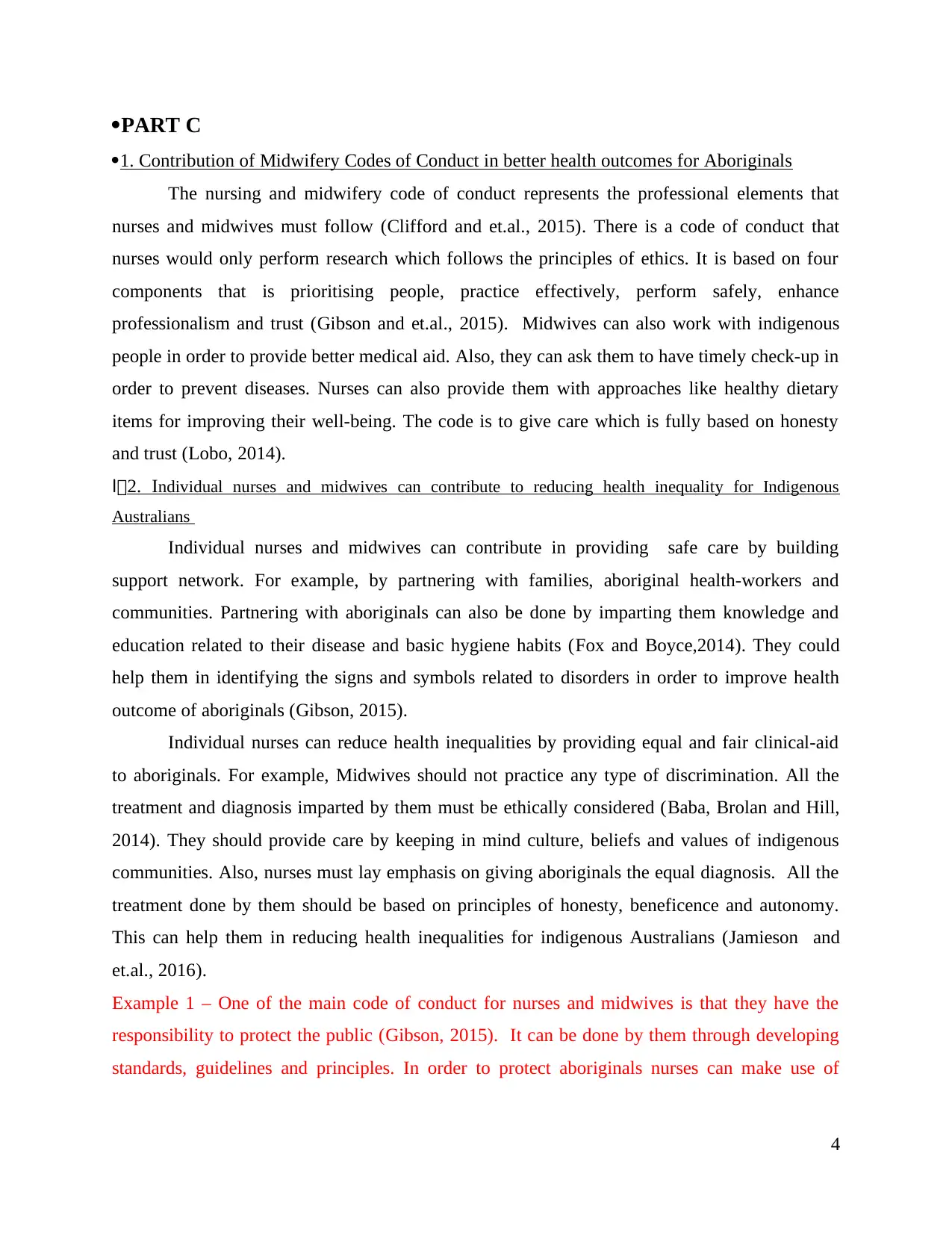
·PART C
·1. Contribution of Midwifery Codes of Conduct in better health outcomes for Aboriginals
The nursing and midwifery code of conduct represents the professional elements that
nurses and midwives must follow (Clifford and et.al., 2015). There is a code of conduct that
nurses would only perform research which follows the principles of ethics. It is based on four
components that is prioritising people, practice effectively, perform safely, enhance
professionalism and trust (Gibson and et.al., 2015). Midwives can also work with indigenous
people in order to provide better medical aid. Also, they can ask them to have timely check-up in
order to prevent diseases. Nurses can also provide them with approaches like healthy dietary
items for improving their well-being. The code is to give care which is fully based on honesty
and trust (Lobo, 2014).
l壱2. Individual nurses and midwives can contribute to reducing health inequality for Indigenous
Australians
Individual nurses and midwives can contribute in providing safe care by building
support network. For example, by partnering with families, aboriginal health-workers and
communities. Partnering with aboriginals can also be done by imparting them knowledge and
education related to their disease and basic hygiene habits (Fox and Boyce,2014). They could
help them in identifying the signs and symbols related to disorders in order to improve health
outcome of aboriginals (Gibson, 2015).
Individual nurses can reduce health inequalities by providing equal and fair clinical-aid
to aboriginals. For example, Midwives should not practice any type of discrimination. All the
treatment and diagnosis imparted by them must be ethically considered (Baba, Brolan and Hill,
2014). They should provide care by keeping in mind culture, beliefs and values of indigenous
communities. Also, nurses must lay emphasis on giving aboriginals the equal diagnosis. All the
treatment done by them should be based on principles of honesty, beneficence and autonomy.
This can help them in reducing health inequalities for indigenous Australians (Jamieson and
et.al., 2016).
Example 1 – One of the main code of conduct for nurses and midwives is that they have the
responsibility to protect the public (Gibson, 2015). It can be done by them through developing
standards, guidelines and principles. In order to protect aboriginals nurses can make use of
4
·1. Contribution of Midwifery Codes of Conduct in better health outcomes for Aboriginals
The nursing and midwifery code of conduct represents the professional elements that
nurses and midwives must follow (Clifford and et.al., 2015). There is a code of conduct that
nurses would only perform research which follows the principles of ethics. It is based on four
components that is prioritising people, practice effectively, perform safely, enhance
professionalism and trust (Gibson and et.al., 2015). Midwives can also work with indigenous
people in order to provide better medical aid. Also, they can ask them to have timely check-up in
order to prevent diseases. Nurses can also provide them with approaches like healthy dietary
items for improving their well-being. The code is to give care which is fully based on honesty
and trust (Lobo, 2014).
l壱2. Individual nurses and midwives can contribute to reducing health inequality for Indigenous
Australians
Individual nurses and midwives can contribute in providing safe care by building
support network. For example, by partnering with families, aboriginal health-workers and
communities. Partnering with aboriginals can also be done by imparting them knowledge and
education related to their disease and basic hygiene habits (Fox and Boyce,2014). They could
help them in identifying the signs and symbols related to disorders in order to improve health
outcome of aboriginals (Gibson, 2015).
Individual nurses can reduce health inequalities by providing equal and fair clinical-aid
to aboriginals. For example, Midwives should not practice any type of discrimination. All the
treatment and diagnosis imparted by them must be ethically considered (Baba, Brolan and Hill,
2014). They should provide care by keeping in mind culture, beliefs and values of indigenous
communities. Also, nurses must lay emphasis on giving aboriginals the equal diagnosis. All the
treatment done by them should be based on principles of honesty, beneficence and autonomy.
This can help them in reducing health inequalities for indigenous Australians (Jamieson and
et.al., 2016).
Example 1 – One of the main code of conduct for nurses and midwives is that they have the
responsibility to protect the public (Gibson, 2015). It can be done by them through developing
standards, guidelines and principles. In order to protect aboriginals nurses can make use of
4
⊘ This is a preview!⊘
Do you want full access?
Subscribe today to unlock all pages.

Trusted by 1+ million students worldwide
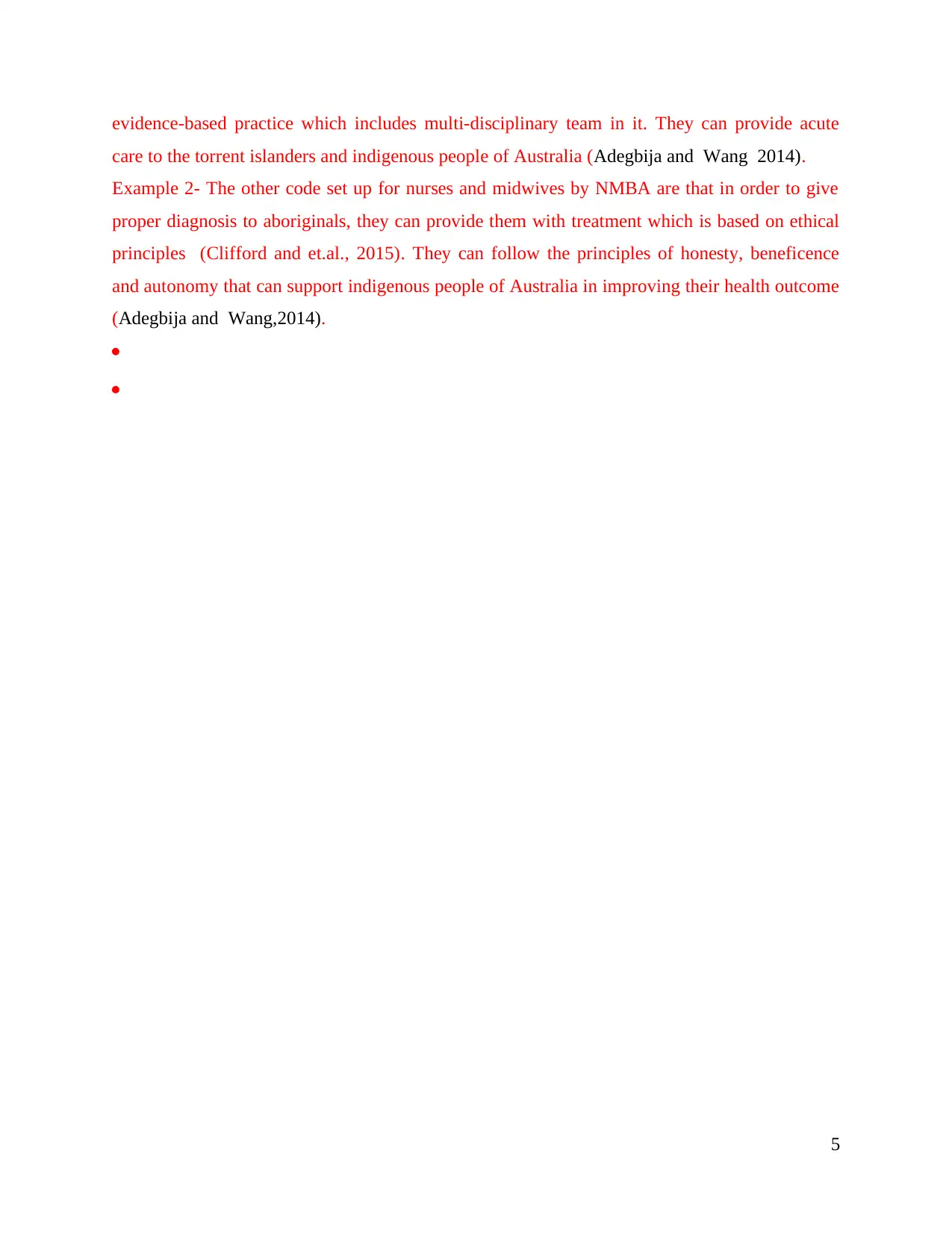
evidence-based practice which includes multi-disciplinary team in it. They can provide acute
care to the torrent islanders and indigenous people of Australia (Adegbija and Wang 2014).
Example 2- The other code set up for nurses and midwives by NMBA are that in order to give
proper diagnosis to aboriginals, they can provide them with treatment which is based on ethical
principles (Clifford and et.al., 2015). They can follow the principles of honesty, beneficence
and autonomy that can support indigenous people of Australia in improving their health outcome
(Adegbija and Wang,2014).
·
·
5
care to the torrent islanders and indigenous people of Australia (Adegbija and Wang 2014).
Example 2- The other code set up for nurses and midwives by NMBA are that in order to give
proper diagnosis to aboriginals, they can provide them with treatment which is based on ethical
principles (Clifford and et.al., 2015). They can follow the principles of honesty, beneficence
and autonomy that can support indigenous people of Australia in improving their health outcome
(Adegbija and Wang,2014).
·
·
5
Paraphrase This Document
Need a fresh take? Get an instant paraphrase of this document with our AI Paraphraser
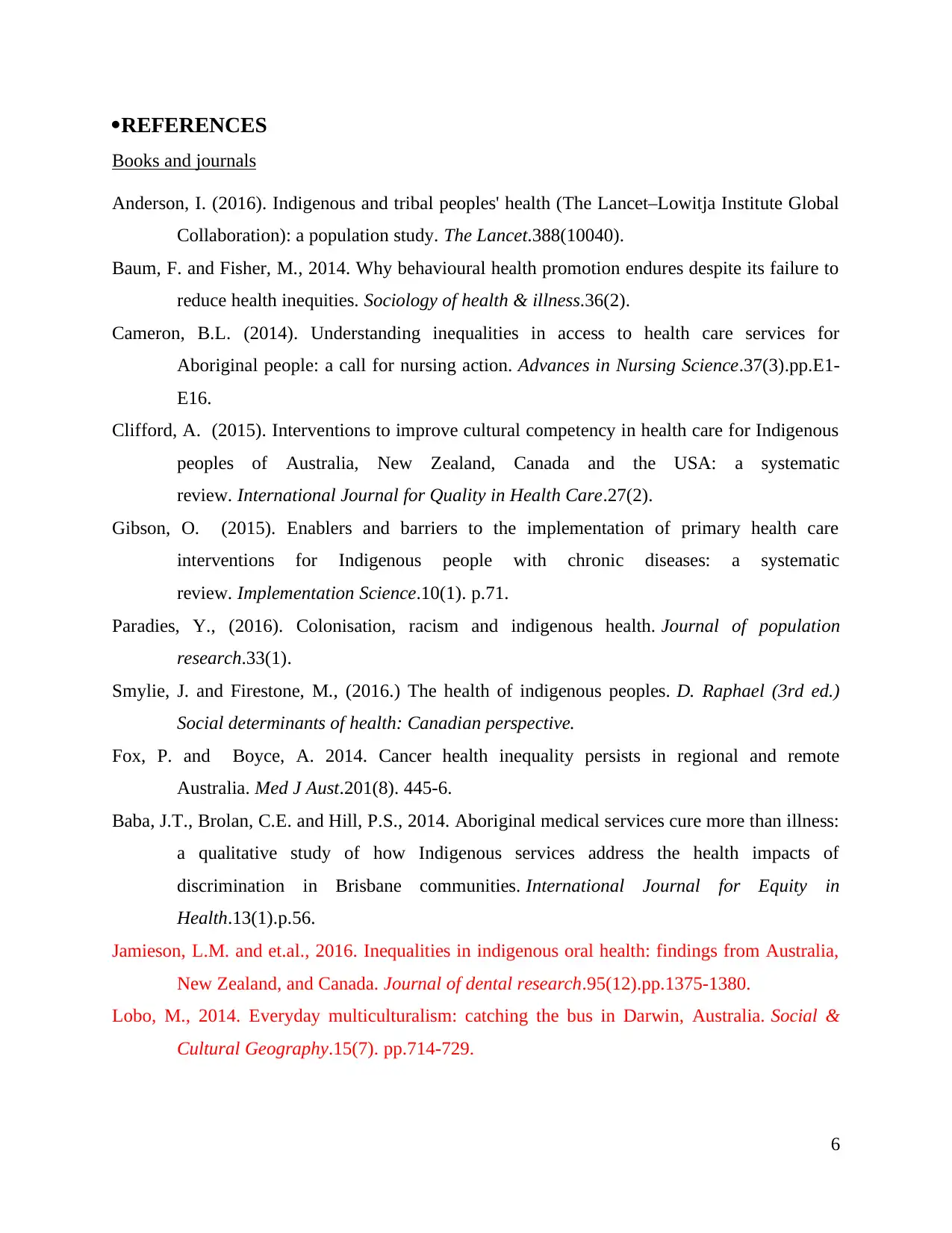
·REFERENCES
Books and journals
Anderson, I. (2016). Indigenous and tribal peoples' health (The Lancet–Lowitja Institute Global
Collaboration): a population study. The Lancet.388(10040).
Baum, F. and Fisher, M., 2014. Why behavioural health promotion endures despite its failure to
reduce health inequities. Sociology of health & illness.36(2).
Cameron, B.L. (2014). Understanding inequalities in access to health care services for
Aboriginal people: a call for nursing action. Advances in Nursing Science.37(3).pp.E1-
E16.
Clifford, A. (2015). Interventions to improve cultural competency in health care for Indigenous
peoples of Australia, New Zealand, Canada and the USA: a systematic
review. International Journal for Quality in Health Care.27(2).
Gibson, O. (2015). Enablers and barriers to the implementation of primary health care
interventions for Indigenous people with chronic diseases: a systematic
review. Implementation Science.10(1). p.71.
Paradies, Y., (2016). Colonisation, racism and indigenous health. Journal of population
research.33(1).
Smylie, J. and Firestone, M., (2016.) The health of indigenous peoples. D. Raphael (3rd ed.)
Social determinants of health: Canadian perspective.
Fox, P. and Boyce, A. 2014. Cancer health inequality persists in regional and remote
Australia. Med J Aust.201(8). 445-6.
Baba, J.T., Brolan, C.E. and Hill, P.S., 2014. Aboriginal medical services cure more than illness:
a qualitative study of how Indigenous services address the health impacts of
discrimination in Brisbane communities. International Journal for Equity in
Health.13(1).p.56.
Jamieson, L.M. and et.al., 2016. Inequalities in indigenous oral health: findings from Australia,
New Zealand, and Canada. Journal of dental research.95(12).pp.1375-1380.
Lobo, M., 2014. Everyday multiculturalism: catching the bus in Darwin, Australia. Social &
Cultural Geography.15(7). pp.714-729.
6
Books and journals
Anderson, I. (2016). Indigenous and tribal peoples' health (The Lancet–Lowitja Institute Global
Collaboration): a population study. The Lancet.388(10040).
Baum, F. and Fisher, M., 2014. Why behavioural health promotion endures despite its failure to
reduce health inequities. Sociology of health & illness.36(2).
Cameron, B.L. (2014). Understanding inequalities in access to health care services for
Aboriginal people: a call for nursing action. Advances in Nursing Science.37(3).pp.E1-
E16.
Clifford, A. (2015). Interventions to improve cultural competency in health care for Indigenous
peoples of Australia, New Zealand, Canada and the USA: a systematic
review. International Journal for Quality in Health Care.27(2).
Gibson, O. (2015). Enablers and barriers to the implementation of primary health care
interventions for Indigenous people with chronic diseases: a systematic
review. Implementation Science.10(1). p.71.
Paradies, Y., (2016). Colonisation, racism and indigenous health. Journal of population
research.33(1).
Smylie, J. and Firestone, M., (2016.) The health of indigenous peoples. D. Raphael (3rd ed.)
Social determinants of health: Canadian perspective.
Fox, P. and Boyce, A. 2014. Cancer health inequality persists in regional and remote
Australia. Med J Aust.201(8). 445-6.
Baba, J.T., Brolan, C.E. and Hill, P.S., 2014. Aboriginal medical services cure more than illness:
a qualitative study of how Indigenous services address the health impacts of
discrimination in Brisbane communities. International Journal for Equity in
Health.13(1).p.56.
Jamieson, L.M. and et.al., 2016. Inequalities in indigenous oral health: findings from Australia,
New Zealand, and Canada. Journal of dental research.95(12).pp.1375-1380.
Lobo, M., 2014. Everyday multiculturalism: catching the bus in Darwin, Australia. Social &
Cultural Geography.15(7). pp.714-729.
6
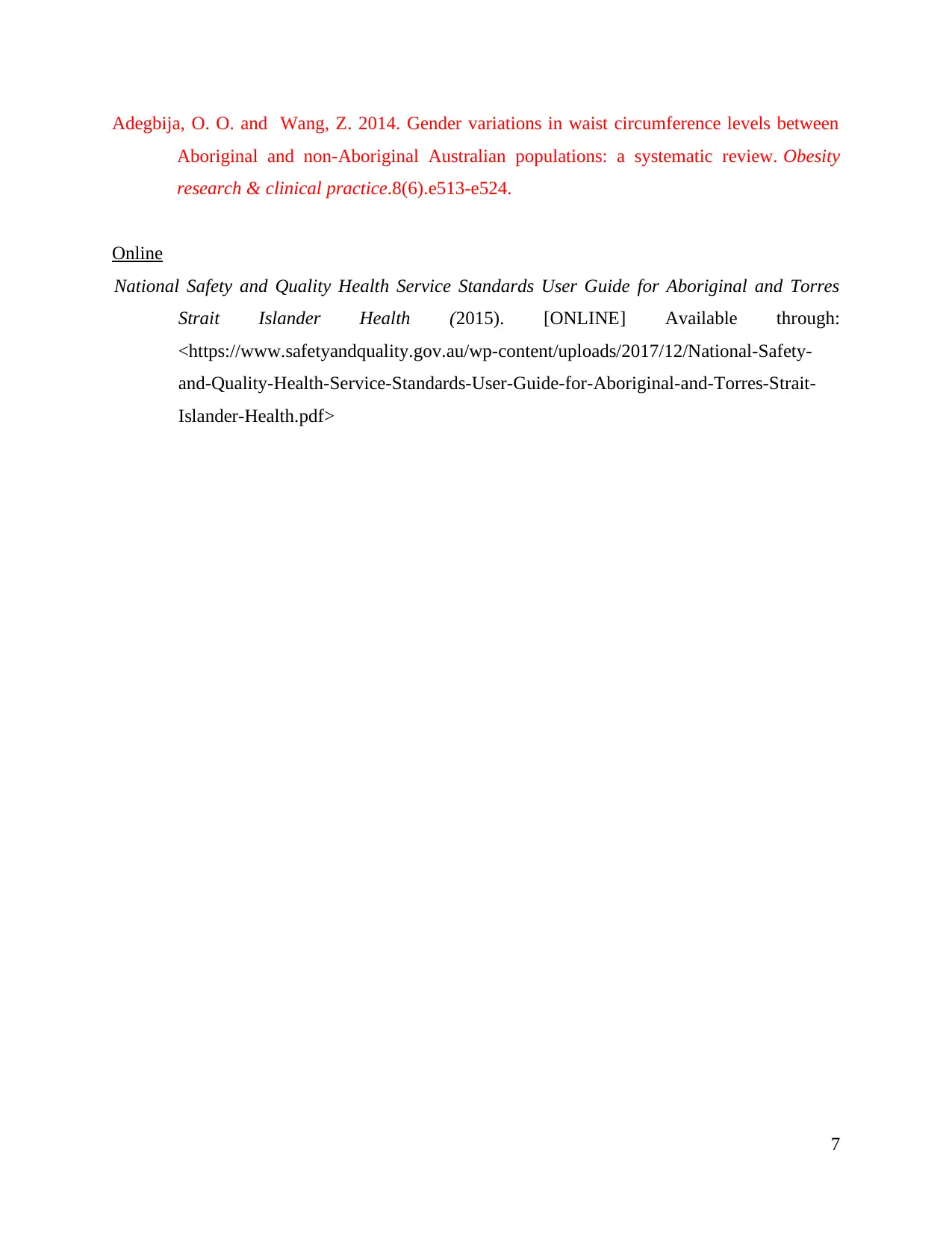
Adegbija, O. O. and Wang, Z. 2014. Gender variations in waist circumference levels between
Aboriginal and non-Aboriginal Australian populations: a systematic review. Obesity
research & clinical practice.8(6).e513-e524.
Online
National Safety and Quality Health Service Standards User Guide for Aboriginal and Torres
Strait Islander Health (2015). [ONLINE] Available through:
<https://www.safetyandquality.gov.au/wp-content/uploads/2017/12/National-Safety-
and-Quality-Health-Service-Standards-User-Guide-for-Aboriginal-and-Torres-Strait-
Islander-Health.pdf>
7
Aboriginal and non-Aboriginal Australian populations: a systematic review. Obesity
research & clinical practice.8(6).e513-e524.
Online
National Safety and Quality Health Service Standards User Guide for Aboriginal and Torres
Strait Islander Health (2015). [ONLINE] Available through:
<https://www.safetyandquality.gov.au/wp-content/uploads/2017/12/National-Safety-
and-Quality-Health-Service-Standards-User-Guide-for-Aboriginal-and-Torres-Strait-
Islander-Health.pdf>
7
⊘ This is a preview!⊘
Do you want full access?
Subscribe today to unlock all pages.

Trusted by 1+ million students worldwide
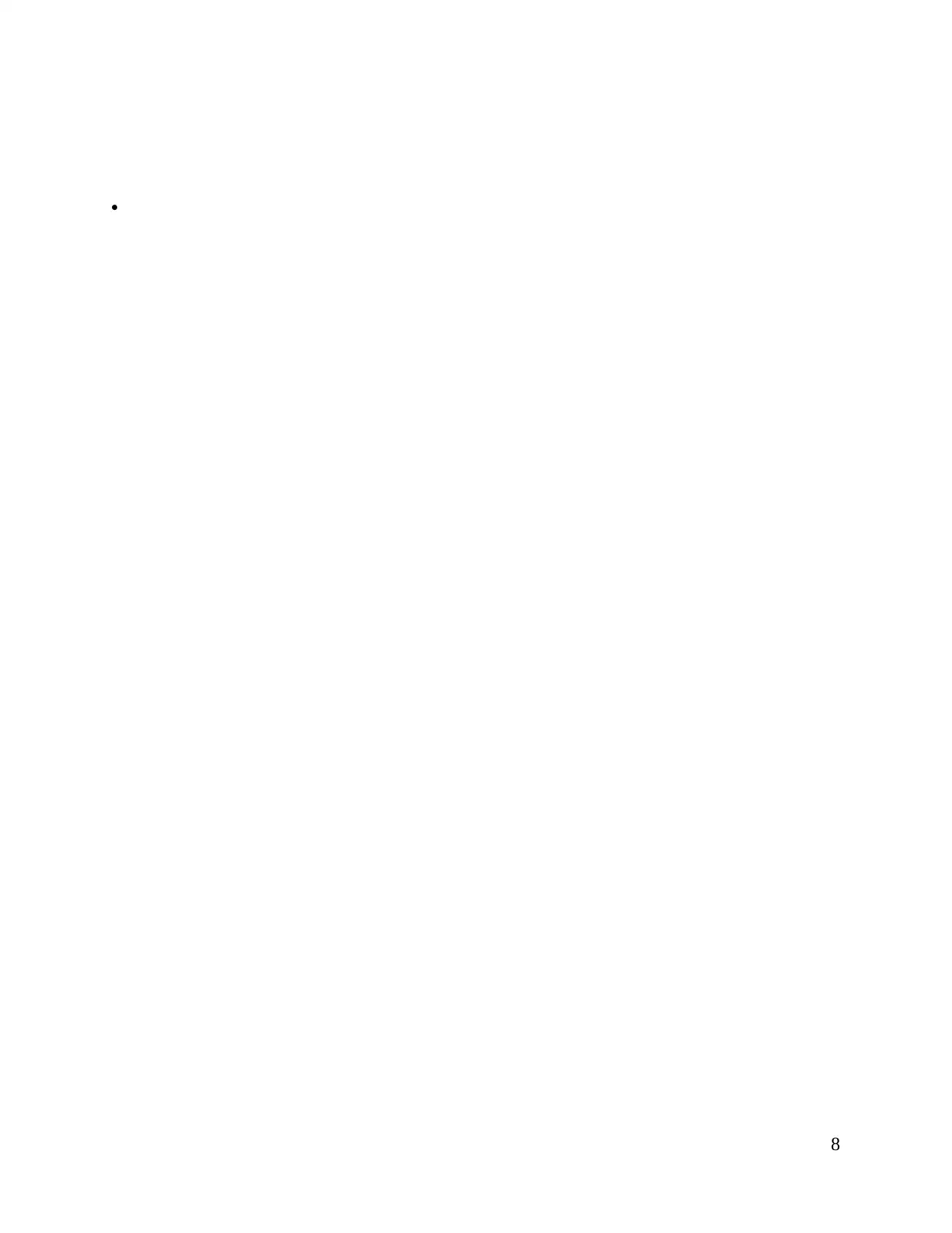
·
8
8
Paraphrase This Document
Need a fresh take? Get an instant paraphrase of this document with our AI Paraphraser
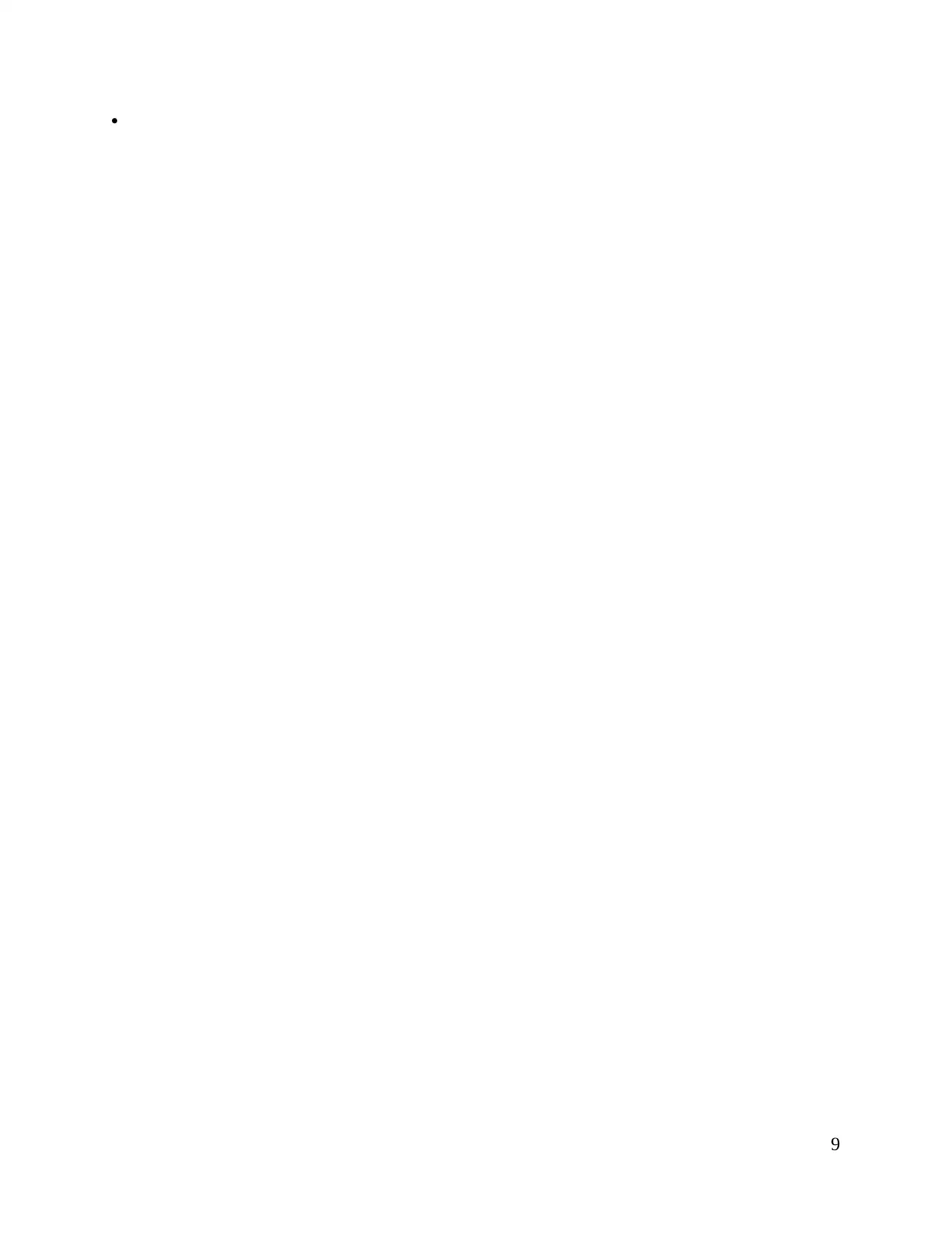
·
9
9
1 out of 11
Related Documents
Your All-in-One AI-Powered Toolkit for Academic Success.
+13062052269
info@desklib.com
Available 24*7 on WhatsApp / Email
![[object Object]](/_next/static/media/star-bottom.7253800d.svg)
Unlock your academic potential
Copyright © 2020–2025 A2Z Services. All Rights Reserved. Developed and managed by ZUCOL.





